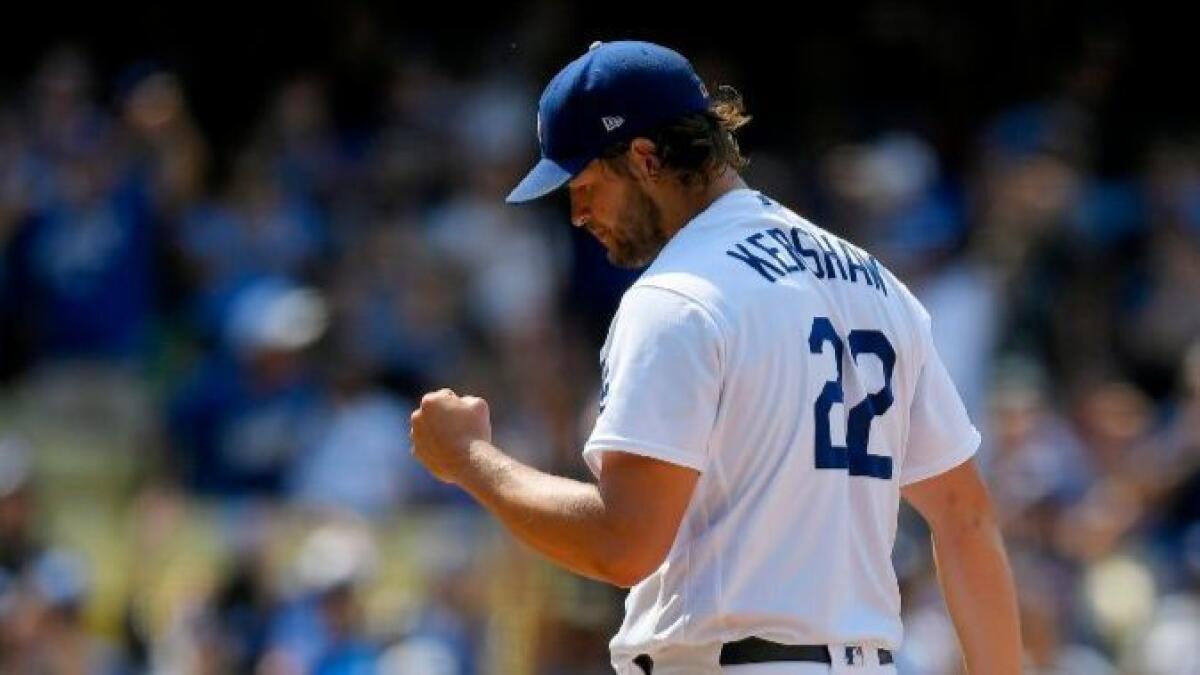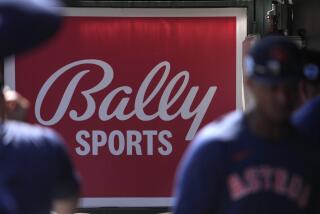Predictions of lavish free-agent spending in baseball could be at odds with cable TV’s fragile state

- Share via
Reporting from Miami — If the 2018 season represents a rainbow, there are many, many pots of gold waiting at the end of it.
So goes the conventional wisdom that has settled over the major leagues, and here at the All-Star game. The greatest free-agent class in major league history is coming, and with it the greatest wave of spending. Bryce Harper is the star of the class, and $400 million is considered an opening bid.
No athlete ever has gotten a contract so rich, and yet that might not be enough. Believe the hype, and you start hearing an auctioneer: Four hundred million! Four, do I hear five? Five hundred million? Do I hear six? Five going once, five going twice … six hundred million!
And not only Harper. Clayton Kershaw could opt out of the final two years and $65 million of his Dodgers contract; he certainly could do better on a new deal. The other free agents next year could include All-Stars Dallas Keuchel, Charlie Blackmon, Craig Kimbrel and Daniel Murphy and stars Manny Machado, Josh Donaldson, Zach Britton and A.J. Pollock.
Two years later, the biggest fish of them all could hit free agency: Mike Trout.
But the predictions of billions and billions in free-agent spending appear at odds with the fragile state of cable television. Baseball’s economic boom has been fueled largely by lavish local cable television contracts, but the model behind those contracts could be creeping toward collapse, with the Dodgers’ blackout just one sign of an unsustainable present.
If Albert Pujols got a 10-year contract at age 31, certainly Harper could sign for 12 years at age 26. But how many owners would consider signing a player to such a long contract if the cable industry as we know it could be dead before Harper’s contract would expire?
Harper’s agent, Scott Boras, said the money will be there because fans will pay to see baseball, however they might see it.
“Everybody wants to see a live performance,” Boras said. “Whether it’s seen on a hand-held device or in the living room is not for me to decide.”
For now, baseball is not turning its back on the industry primarily responsible for propelling the sport’s annual revenue beyond $10 billion a year, a surge from $1.2 billion 25 years ago.
“We will continue to be as supportive of the cable model as we possibly can,” Commissioner Rob Manfred told The Times.
“Is it going to be as big as it was 10 years ago? Maybe not. But there is going to be some core of the cable model. It is important to our economics.”
Manfred said he sent a memo to clubs, encouraging them to remind their broadcast partners that cable broadcasts can be streamed to local fans, directly from the cable company or from another streaming provider such as Hulu or Sling.
He does not see a la carte programming — that is, customers pay only for the Dodgers, or whatever other individual channels they want — as the wave of the future.
“Consumers are going to figure out,” Manfred said, “that when you add it all up, you get more value out of a bundle than you do when you go out there and try to piece together your own entertainment product.”
At the heart of the cable model is the ability to charge a customer for channels they do not watch. All Charter Spectrum customers pay for the Dodgers channel, but only about 5% watch it.
But the rising cost of sports rights and the growing number of cord-cutters — viewers getting their television fix from streaming, not cable or satellite — has made cable companies increasingly resistant to add a high-priced sports channel to their bundles.
The New York Yankees were off the air in much of their market for one year and the San Diego Padres for two. Those situations have been resolved, but the Houston Astros’ cable channel went bankrupt, and the Dodgers’ blackout is deep into its fourth year. (Charter generates $30 billion a year in revenue; it’s not going bankrupt.)
ESPN lost 11 million subscribers over the last decade.
“I think every team owner should be scared right now, looking at the TV ecosystem cracking,” said Rich Greenfield, a media analyst with the New York firm BTIG Research.
The stars of 2018 might get their money, but the free agents beyond might be less likely to get a fat contract until baseball’s broadcast future becomes less cloudy, said Sal Galatioto, whose New York-based Galatioto Sports Partners firm brokers the sale of sports franchises.
“This is going to be a record free-agent class,” Galatioto said, “but there are only going to be a handful of really, really high-priced free agents, and there are 30 teams. So I think those guys will get paid.”
Of the 30 major league teams, all but 11 either own their cable channel or have contracts that extend beyond 2025.
The greatest concern to an owner, Galatioto said, is that cable subscriptions decline so dramatically that a regional sports network declares bankruptcy and the funds that fueled big-money player signings are jeopardized.
“The risk to the owner is that his existing cable contract can’t pay out,” he said. “It’s a credit risk more than anything else. Most of the contracts aren’t short-term. Almost all of them are longer than the life of those [player] contracts will be.”
The power of live sports to attract audiences has lured new competitors beyond traditional television outlets, said Ed Desser, president of Santa Monica-based Desser Sports Media, the former president of NBA TV.
Facebook and Twitter are experimenting with MLB streaming this season, and either company’s acquiring exclusive rights in any market could bring a financial windfall. Amazon will stream Thursday NFL games this fall.
“Five or 10 years ago, Amazon was selling books,” Desser said. “Sports has gotten disproportionately more important to own. All of these forces are conspiring to keep the pressure high and going higher, even though it’s plain to see some people are losing some subscribers and losing some revenues.
“There are no fewer sports fans. Maybe the model has to get tinkered with a little bit, but I just don’t see the sky falling here.”
Greenfield isn’t exactly calling Chicken Little, but he does not buy the notion that the billions that have enriched a generation of players will always be there just because fans will always be there.
“What we don’t know right now is, are there new bidders that are going to come in and spend hundreds of millions, let alone, billions of dollars?” Greenfield said. “Do you have a Facebook or a Google or an Amazon or an Apple who is ready to plunk down that kind of money? It’s not clear yet.
“But, if you’re a baseball owner, you better hope that there is. Because the gravy train from the legacy cable ecosystem is coming to an end. They’ll need to find new buyers willing to keep that gravy train running.”
Follow Bill Shaikin on Twitter @BillShaikin
More to Read
Go beyond the scoreboard
Get the latest on L.A.'s teams in the daily Sports Report newsletter.
You may occasionally receive promotional content from the Los Angeles Times.











